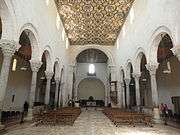Otranto Cathedral

Otranto Cathedral (Italian: Duomo di Otranto; Basilica Cattedrale di Santa Maria Annunziata) is a Roman Catholic cathedral in the Italian city of Otranto, dedicated to the Annunciation of the Virgin Mary. It is the archiepiscopal seat of the Archdiocese of Otranto. The cathedral was consecrated in 1088. It is 54 metres long by 25 metres wide and is built on 42 monolithic granite and marble columns from unknown quarries. Its plan is a three-aisled nave with an apsidal east end. On either side of the west facade are two lancet windows.
History
Foundation

Built on the remains of a Messapiic village, a Roman house and an early Christian church or temple, the cathedral was founded in 1068 by the Norman bishop William or Guglielmo. It is a synthesis of varied architectural styles, with Byzantine, early Christian and Romanesque elements. It was consecrated on 1 August 1088 under the papacy of pope Urban II by the papal legate Roffredo, archbishop of Benevento. The nave's partly surviving frescoes include Byzantine traces, such as the image of the Madonna and Child in the south nave and the crypt running under the apse, the sanctuary and part of the nave – dates back to the original 11th-century church – this crypt is a miniature of the famous Cistern of Theodosius or the Mosque–Cathedral of Córdoba. It has three semicircular apses and forty-eight bays interspersed with over seventy columns and pillars. It is especially marked by supporting elements from ancient and early medieval buildings. Its surviving frescoes cover a range from the Middle Ages to the sixteenth century.
12th century


The mosaic running the whole length of the nave, sanctuary and apse is 12th century in date – it was commissioned by the first Latin archbishop of the city, Gionata, and created between 1163 and 1165 by a group of artists led by Pantaleone, a Basilian monk from the monastery of San Nicola di Casole. It shows scenes from the Old Testament and chivalric cycles, as well as figures from medieval bestiaries, arranged alongside a 'tree of life', showing human experience from the Fall to salvation.
The bell tower next to the cathedral was also built in the 12th century. It is square in plan, with four round-arched windows. Its exterior decoration recalls the military architecture of the city's walls and towers. It is built of carparo and white limestone, typical of the Salento region. What survives of the tower is probably only the base of a taller structure also used as an observation platform overlooking the city and the coast, from which the alarm could be raised if an army approached – this secular usage justified it not being joined to the cathedral itself. It has bronze bells, cast over the centuries by the will of various ecclesiastical clients.
15th century

In August 1480, clergy and survivors of the Ottoman siege of Otranto took refuge in the cathedral – the Ottoman force eventually broke in and killed those inside, turning the church into a stable or a mosque and destroying its 13th-century frescoes. After Otranto was retaken in 1481 by a force under Alfonso V of Aragon it was turned back into a church and heavily rebuilt to house the relics of the Martyrs of Otranto, who had been executed after the 1480 siege. The reconstruction included the rose window on the gabled west front, with 16 rays of fine Gothic tracery converging at the centre according to the canons of Gothic architecture. In the south aisle is the Chapel of the Martyrs, built by order of Ferdinand I of Naples and rebuilt at public expense in 1711 – this houses the relics of the martyrs in seven large coffins. Behind the chapel's altar is the 'stone of martyrdom', traditionally held to be that used to behead the martyrs.
16th century to present
A north-west door was built in the late 15th or early 16th century by Nicholas Fernando on the instructions of archbishop Serafino da Squillace, whose figure was carved on the structure. In 1674 a Baroque west door was added, consisting of two half-fluted columns on either side holding up the pediment, with the coat of arms of Archbishop Gabriel de Santander Adarzo supported by two angels. In the north aisle is a baroque baptistery commissioned by archbishop Michele Orsi in the mid 18th century, a burial monument to Francesco Maria de Aste (died 1719) and the mausoleum of the metropolitan Gaetano Cosso (died 1655). In 1693 archbishop Francesco Maria De Aste built the triumphal arch and in 1698 covered the central nave and the sanctuary with a black, white and gilded wooden ceiling. In the sanctuary is the high altar with the 18th-century altar frontal, embroidered in silver with a scene of the Annunciation.
In 1827 archbishop Andrea Mansi had a painted panel ceiling built over the side aisles – in these aisles are six altars dedicated to the resurrection of Jesus and saint Dominic of Guzman, to the Virgin Mary (to the right), to Pentecost, the Visitation of the Blessed Virgin Mary and Saint Anthony of Padua (to the left).
External links
Coordinates: 40°08′45″N 18°29′28″E / 40.1458°N 18.4910°E